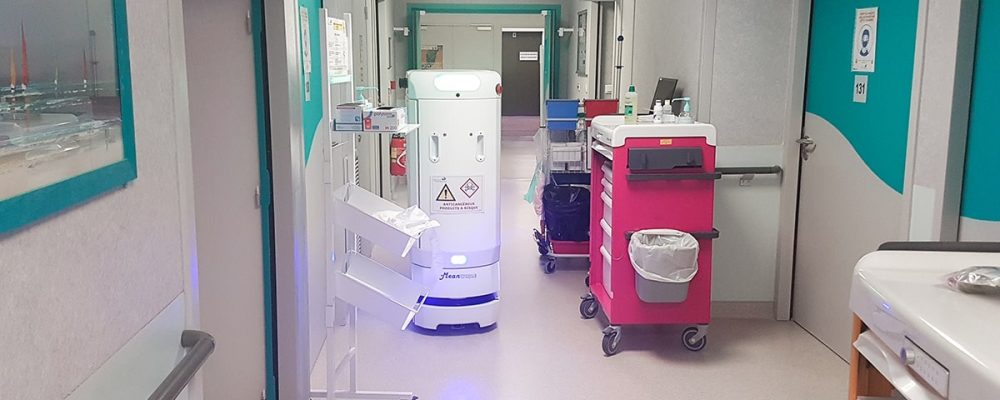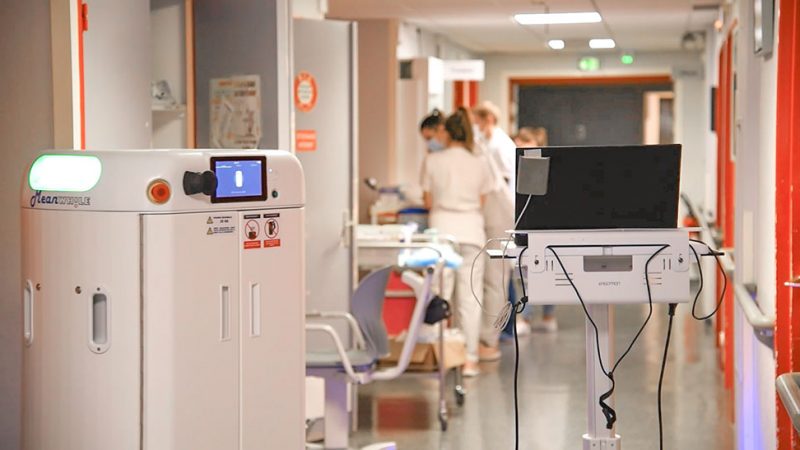
Interview: Transport of chemotherapy, a robot assists caregivers
- Expertise
- Temps de lecture : 10 min
On the occasion of the Spring of Robotics, Eric LEMONNIER, Logistics Manager at the Center Hospitalier de Cholet, spoke to share his experience on the installation of an autonomous mobile robot within the Hospital Center.
Mr. LEMONNIER’s main mission is to manage the establishment’s logistical services, with in particular the overall management of the flow of support services to the care units. At the Cholet hospital center, the evolution and improvement of hospital logistics are the subject of a global reflection with, among other things, the implementation of “last-meter logistics” for the benefit of healthcare professionals.
Some figures to present the CH of Cholet?
“The Cholet Hospital Center in 2020 is:
- More than 800 beds;
- 2,000 births;
- 735,000 meals produced;
- 1,000 tonnes of laundry washed. »
What was your problem and your initial need?
“For the Center Hospitalier de Cholet, we had to find a reliable and safe solution to manage flows as part of a project with a reorganization of floor logistics. We had to transport pharmacy products, more precisely chemotherapy.
And that’s when Tony Perlemoine, Logistics Project Manager at Nantes University Hospital, presented his autonomous robotics solution to us.”
What solution did you implement?
“During its day of activity, the robot will take care of all the chemotherapy. That is to say that from 8:45 a.m. to 4:45 p.m., the robot will make deliveries as needed. The chemotherapies are therefore ordered by the professionals of the Oncology department and are prepared progressively to then be validated and delivered by the robot as soon as they are ready. With this fluidity of shipments, the waiting time decreases, the patient no longer waits.
Each circuit is secure: When the pharmacist uses the robot, he identifies himself, deposits the chemotherapy inside it, validates his destination on the screen and then the robot goes off to deliver. The robot, leaving the pharmacy, goes through an automatic door and reserves the elevator. When it arrives in the care unit, the corridors are sometimes cluttered and narrow, the robot shows great agility by sneaking up to its delivery point. When the robot encounters a bed or a stretcher, the trained professional will perform a manipulation in order to move the robot to the side and allow the passage of the bed or the stretcher, the robot then resumes its journey.
Once at its destination, the robot “parks” at the planned location and contacts the agents on the phone. This system works very well.
During the day, XuP-Med will also be able to “re-deliver” medication. Indeed, we are working on “full-empty” solutions for pharmacy cabinets. Requests made by prescription can complete these cabinets with specific drug needs. The robot is configured to deliver each nursing computer, we really optimize its use.”
What are the missions that the robot performs at night?
“At 4:45 p.m. the robot leaves to dock (= park on its charging station) in the emergency room. He remains available to the teams and will manage all blood flows from the emergency room to the laboratory until 8:45 the next morning. Over a weekend, this can represent an average of twenty kilometers.
The obstetrical unit, which is located 300 meters away, is also able to call the robot: this prevents the agents from moving around, so they can stay with the patients. “
Did this solution meet your expectations and needs?
“Today this solution works very well. Regarding flows, this solution is efficient, travel times are regular: the robot will take on average between 4 and 5 minutes for each mission, which is very reassuring and safe for professionals.
It is also important to point out that hospitals can often be under construction and this robotic solution makes it possible, via the re-configuration of a new map, to deviate and modify its routes in order to adapt to a new route.”
What are the benefits for your teams?
“Previously it was an agent who went down to the pharmacy and made deliveries, today he will be able to devote himself to other more interesting and rewarding missions.
Today, the robot is essential for caregivers. They learned to use it and adapted to this tool, which was baptized “Walli”. He is regularly photographed and filmed in the corridors.”

Did you have any special requests regarding the appearance of the robot?
“At the Cholet hospital, we chose a robot with a total height of 145 cm in order to make it easier for the teams to accept and manage manipulations (human-machine interractions), but also so that it blends into the hospital landscape.”
And in terms of security?
“Here each circuit is secure, the person who will put the products in the robot will not be able to receive them, it is the laboratory agent who will be able to collect the delivery once it has arrived at its destination. The traceability of the products is guaranteed, it is imperative. “
And to conclude ?
“Support for the implementation of this solution has been and remains an important point for the Cholet hospital center: when you have a question, you get a very quick response from an identified team of professionals who follow up on it.
Today the robot is used by the pharmacy team, but also by hospital service agents, caregivers, nurses and laboratory technicians. By scanning the card, they identify themselves, depending on their rights, the door opens, they can load and order a feed or retrieve the products. When the robot has been delivered to the laboratory or to oncology, all you have to do after collecting the products is to press the message on the man-machine interface inviting you to restart the robot, which will immediately go back to docking. Each manipulation is traced and each circuit is secure. The most beautiful illustration is to come and see how the robot works on site
and listen to the professional users in real situations.”